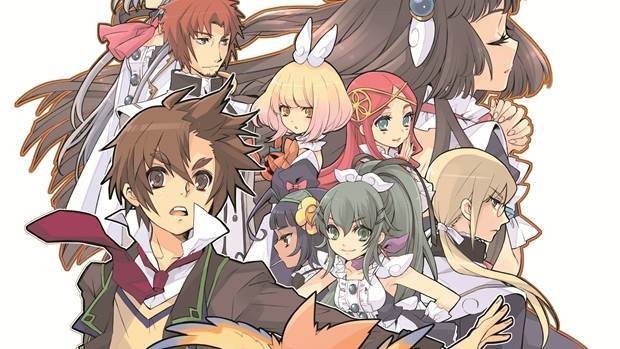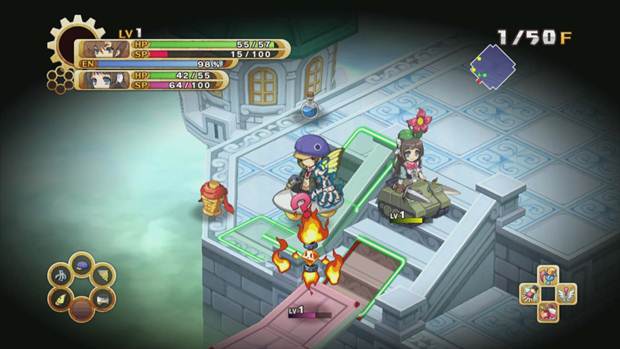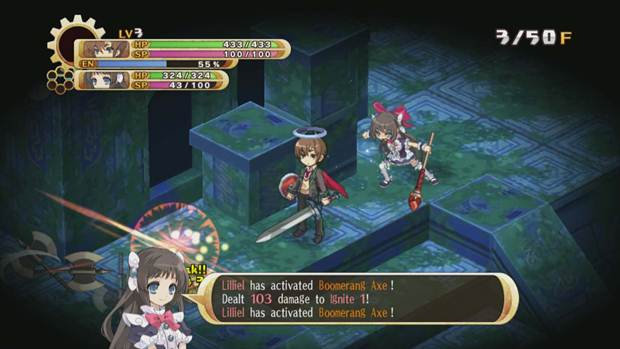
Developed by Nippon Ichi Software, the same team behind the Disgaea series, The Guided Fate Paradox is the second game out of three said to release this year for the American and European audience. Already released in Japan during the start of the year, 2013 is shaping up to be a pretty good year for those who are fond of JRPGs. But does The Guided Fate Paradox hold up well against other games within the same genre? Is it worthy enough to stand alongside Disgaea D2: A Brighter Darkness? Read on to find out.
After years of bad luck with just about every scenario that comes into play, Renya Kagurazaka is a sarcastic high school student who mocks his own karma. After he stumbles across a lottery machine ticket at his local city mall, karma decides to talk back. Tempted by a young woman dressed as a maid Renya tries his luck, and much to his own surprise wins the draw. However Renya thinks the whole thing is a hoax and stands in embarrassment and is just about ready to leave, but not before he is knocked unconscious and transported to the magical lands of Celestia.
Here he awakens to find that this is not a hoax and that he really is in-fact turned into a super human being, and the girl in the shopping mall is infact a guardian named Lilliel Saotome, who has set him up to take on the role. From here on out Renya’s role in the game is to fulfill the wishes of the people and to do so by any means necessary. Using a machine called the Fate Revolution Circuit, Renya is able to battle the inner demons that people have inside their minds. These inner demons are the doubts, fears, and insecurities that plague people’s dreams and hopes that they have in order to better their lives. The entire game holds a sense of sarcasm and comedy that creeps up you when least expected.
Renya helps to better the lives of the people using not only the Fate Revolution Circuit, but also with the assistance of Lilliel. She plays two roles in the game, the first is that she’s Renya’s assistant for the bulk of the story or guardian if you will, no pun intended. The other being that she is the player’s hint and tutorial guide for the progress of the game. This does well to blend the technical aspects of the player who is playing the game, with the story and reasoning behind the character’s choices and interactions within the game. There’s a seamless transition between the two that works out well on both ends.
"Early hours into the game there's a slight sense of mystery within the characters. This is rooted from their dialogue and their attitudes towards Renya."
The play of stereo-typical male humour on the appearance of female cosplay is one that deserves credit. Renya’s dialogue as he greets the guardians are not to be missed. The game provides a few witty laughs along the way as Renya questions his role as super human being in reference to the laws of a video game. As the game is primarily a dungeon crawler Renya questions the idea of looting and finding HP items on the floor. In addition the game also crosses the fourth wall more than often which is laughable and noticeable as Renya’s sense of personality is both easy to relate to as it is convincing.
The Celestia works as a hub or a base for when the player is not taking part within the main section of the game. In the Celestia you are free to browse item shops, weapons, equipment, and talk to other beings. The main game takes place inside the Fate Revolution Circuit, which is traversed by exploring a series of floors which are home to different creatures and booby traps. The player is free to navigate the different floors at any time so long as they have access to the portals which link them together.
As you progress through the different floors, cut-scenes take place displaying the lives and status of the person you are helping. Your actions of helping a particular person by the means of battling opponents begins to have an effect on the world in which that person exists. The Fate Revolution Circuit copies specific environmental elements from the original world and mixes them in with that of the Celestial to create the Copy World. The game explains how all this works through the use of character dialogue, but it could do a better job of doing so. This ties into the story of the game in that Renya cannot directly help humans but must assist them through the machine in an effort to guide their thoughts. It’s a way for the Renya to help people out without ever having to come into contact with them physically.
Early hours into the game there’s a slight sense of mystery within the characters. This is rooted from their dialogue and their attitudes towards Renya. Among the beautiful creatures and the kind-hearted people of the Celestia you can’t help but get the feeling that there’s something sinister and maybe something a little twisted going on behind closed doors. Your need for a reason as to why Renya was chosen to be special is something you personally want to seek out.
"Playing in a similar method to Disgaea D2: A Brighter Darkness, the game uses a turn-based strategy system in which players must do battle with enemies in the form of a grid, where each enemy engages an attack one after the other. "
The clown faced beings and Harpy style monsters don’t exactly blend in well with the human-like creatures that roam the Celestia. Their hierarchy structure of non-human like creatures being servants to the guardians played on my mind, and it constantly had me thinking that nothing is what it seems within the Celestia. It was this mystery along with Renya’s so-called “Lucky draw” that motivated me to go on with the game and see it through to the end.
One thing that stood out to me as a player is the method in which the game teaches you how to play. The game treats the player and Renya as one, the tutorial levelling where Lilliel teaches Renya his new abilities is the same way in which you are shown how to play the game. It’s a seamless integration that fools the player into believing that Renya’s tutorial is more to do with the story than the actual player learning the control scheme of the game. It works magnificently.
Playing in a similar method to Disgaea D2: A Brighter Darkness, the game uses a turn-based strategy system in which players must do battle with enemies in the form of a grid, where each enemy engages an attack one after the other. Where The Guided Fate Paradox does things different lies in its freedom to move about the battle grid when the player desires, rather than having to do so in the form of an action that’s part of your actual turn. It also uses this sense of freedom in its method of using items and equipping weapons. The player’s combat options are paired up with a 6-skill attribute system that has a specific effect on enemy types.
Renya has the ability to heal outside of battle without the need of an item which contradicts the game’s use of finding and buying items from the game’s store even though they come in handy once you’re in battle, which the self-healing does not. Although there’s no options for co-operative play there is the ability to travel with your guardians and have them assist you in battle. A more interesting method of raising your stats and abilities is by use of the Divinigram. The Divinigram acts as a gym for more advanced player upgrades. Here you are able to plant specific items into a panel-like structure which raises your base strength for that given item type.
"When you're not taking part in immediate battles you are free to wonder the available areas within the Celestia. Although these areas are not that great in size the choice of doing so allows you to interact with other characters within the world, and increase your immersion."
Planting the a relic for example increases your attacking hit points while others will allow you to attack more often within a given turn and become more aware to evasive manuvoures. Unlike other items and equipment that you attach in order to increase your chance of survival and strengthening your attacks, which are lost and reset if you should lose all your health, your base stats which you improve in the Divinigram are not lost but are permanent.
The guardians are able to heal you, throw you at enemies, and pass on their items. They can also take on a different attitude towards the battles, with the choices of being more defensive, covering the player, and being full on aggressive. The game extends upon this with the options to equip and switch items with your companions, as well as give orders to execute special abilities known as Divine Skill. These special attacks are available to you depending on what weapons you are equipped with and plays out in a stylish anime-like cut-scene.
As the guardians accompany you and are able to freely move you when in battle, this also means they are free to attack and you do not have direct control over their actions. While this is handy in certain situations it can be troublesome when you wish to approach an enemy in a particular way or sneak past them. But because your partner has already taken it upon herself to engage the enemy first, you are unable to do so.
When you’re not taking part in immediate battles you are free to wonder the available areas within the Celestia. Although these areas are not that great in size the choice of doing so allows you to interact with other characters within the world, and increase your immersion. The Celestia is a hub so the sense of huge exploration in comparison to what goes on in the Fate Revolution Circuit is not needed. The game already does a terrific job of immersing you within its storyline and Renya’s character, the walkabout nature of the hub still compliments the game and is a nice implementation.
"The improvements and exploration that the game has taken is a leap above Disgaea D2: A Brighter Darkness, and because of the close similarities between them the changes here are very well noticeable."
The game also adds a light customisation element whereby you can rename each of your weapons by visiting the Cigamis. As you progress through the game you’ll find more and more options for item techniques and upgrades, as well as more stores becoming available for customization purposes. Just visiting these stores and wondering around the Celestia opens up more background information of its world, thanks to the talkative nature of the creatures that inhabit it.
The game’s visual style shares similarities to that of Nippon Ichi’s other titles, primarily Disgaea D2: A Brighter Darkness. The visuals aren’t bad by any means but the need for changing things up a little in order to distinguish the two titles is really down to personal preference. The game looks amazing in its own right and the anime art style that exist within the cut-scenes go hand in hand with the personalities of the game’s characters. The game boast many different environments that are discovered as you play on and as they are all very distinct from the last, the effort in its level design is appreciable and compliments its visual theme.
The improvements and exploration that the game has taken is a leap above Disgaea D2: A Brighter Darkness, and because of the close similarities between them the changes here are very well noticeable. The Guided Fate Paradox is rewarding in its storytelling and does well to hook you from the beginning. Those who see it through to the end will not be disappointed.
This game was reviewed on the PlayStation 3.
The game’s storyline alone is enough to keep players going and the rest is a well-deserved bonus.
The only hiccup in my experience of the game was the non-optional aspect of adjusting the difficulty in reference to losing the equipment and items I had gained while travelling through the worlds. This became a pain but is countered by the aspect of challenge and decision making.



















